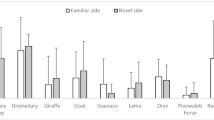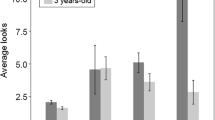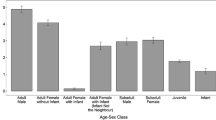Abstract
Numerous conflicting results exist in the primate literature regarding the role of dominant individuals in creating conditions of social anxiety. Self-directed behaviors (SDB) have been used as an indicator of increased anxiety in primates to examine the effects of social stimuli such as dominance and association. This study recorded SDB from 11 free-ranging female vervets in the semi-arid Klein Karoo region of South Africa for a total of 468 focal hours to determine whether anxiety was influenced by the hierarchical rank of, and degree of association with, neighboring monkeys. Associates were dyads that spent long periods of time together, i.e., proximity sociality index scores in the top 40% of all scores, and nonassociate dyads spent very little time together, i.e., scores within the bottom 40% of all scores. Rates of SDB were significantly higher when dominant neighbors were nonassociates vs. associates. The rate of SDB when neighbors were dominant associates vs. subordinate associates did not differ. These findings indicate that anxiety is influenced to a greater extent by the degree of association with neighboring monkeys than by hierarchical rank. Measurement of multiple social variables can elucidate the relative contributions of the variables to changes in SDB and demonstrate how the variables interact, thereby providing a more comprehensive understanding of conditions leading to changes in social anxiety.


Similar content being viewed by others
References
Altmann, J. (1974). Observational study of behavior – sampling methods. Behavior, 49(3–4), 227–267.
Aureli, F., & Van Schaik, C. (1991). Post-conflict behavior in long-tailed macaques (Macaca fascicularis): II. Coping with the uncertainty. Ethology, 89(2), 101–114.
Aureli, F., Preston, S., & De Waal, F. (1999). Heart rate responses to social interactions in free-moving rhesus macaques (Macaca mulatta): a pilot study. Journal of Comparative Psychology, 113(1), 59–64.
Bergman, T. J., Beehner, J. C., Cheney, D. L., & Seyfarth, R. M. (2003). Hierarchical classification by rank and kinship in baboons. Science, 302, 1234–1236.
Castles, D., & Whiten, A. (1998). Postconflict behavior of wild olive baboons – II. Stress and self-directed behavior. Ethology, 104(2), 148–160.
Castles, D., Whiten, A., & Aureli, F. (1999). Social anxiety, relationships and self-directed behavior among wild female olive baboons. Animal Behavior, 58(6), 1207–1215.
Cheney, D. L., & Seyfarth, R. M. (1983). Nonrandom dispersal in free-ranging vervet monkeys: social and genetic consequences. The American Naturalist, 122(3), 392–412.
Cords, M. (1997). Friendships, alliances, reciprocity and repair (pp. 24–49). In A. Whiten & R. W. Byrne (Eds.), Machiavellian intelligence II: Extensions and evaluations. Cambridge: Cambridge University Press.
Daniel, J., dos Santos, A., & Vicente, L. (2008). Correlates of self-directed behaviors in captive Cercopithecus aethiops. International Journal of Primatology, 29(5), 1219–1226.
Das, M., Penke, Z., & van Hooff, J. (1998). Postconflict affiliation and stress-related behavior of long-tailed macaque aggressors. International Journal of Primatology, 19(1), 53–71.
David, H. A. (1988). The method of paired comparisons. London: C Griffin.
de Vries, H., Stevens, J., & Vervaecke, H. (2006). Measuring and testing the steepness of dominance hierarchies. Animal Behavior, 71(3), 585–592.
Kutsukake, N. (2003). Assessing relationship quality and social anxiety among wild chimpanzees using self-directed behavior. Behavior, 140, 1153–1171.
Maestripieri, D., Schino, G., Aureli, F., & Troisi, A. (1992). A modest proposal: displacement activities as an indicator of emotions in primates. Animal Behavior, 44(5), 967–979.
Manson, J., & Perry, S. (2000). Correlates of self-directed behavior in wild white-faced capuchins. Ethology, 106(4), 301–317.
McDougall, P., Forshaw, N., Barrett, L., & Henzi, S. P. (2010). Leaving home: responses to water depletion by vervet monkeys. Journal of Arid Environments, 74, 924–927.
Miller, G. (1997). Protean primates: The evolution of adaptive unpredictability in competition and courtship (pp. 312–340). In A. Whiten & R. W. Byrne (Eds.), Machiavellian intelligence II: Extensions and evaluations. Cambridge: Cambridge University Press.
Schino, G., & Aureli, F. (2008). Trade-offs in primate grooming reciprocation: testing behavioral flexibility and correlated evolution. Biological Journal of the Linnean Society, 95(3), 439–446.
Schino, G., Maestripieri, D., Scucchi, S., & Turillazzi, P. G. (1990). Social tension in familiar and unfamiliar pairs of long-tailed macaques. Behavior, 113(3–4), 264–272.
Schino, G., Perretta, G., Taglioni, A., Monaco, V., & Troisi, A. (1996). Primate displacement activities as an ethopharmacological model of anxiety. Depression and Anxiety, 2(4), 186–191.
Seyfarth, R. M. (1980). The distribution of grooming and related behaviours among adult female vervet monkeys. Animal Behavior, 28(3), 798–813.
Silk, J. B. (2002a). The form and function of reconciliation in primates. Annual Review of Anthropology, 31(1), 21–44.
Silk, J. B. (2002b). Practice random acts of aggression and senseless acts of intimidation: the logic of status contests in social groups. Evolutionary Anthropology, 11(6), 221–225.
Silk, J. B., Altmann, J., & Alberts, S. C. (2006a). Social relationships among adult female baboons (Papio cynocephalus) I. Variation in the strength of social bonds. Behavioural Ecology and Sociobiology, 61, 183–195.
Silk, J. B., Altmann, J., & Alberts, S. C. (2006b). Social relationships among adult female baboons (Papio cynocephalus) II. Variation in the quality and stability of social bonds. Behavioural Ecology and Sociobiology, 61, 197–204.
Spruijt, B., Van Hooff, J., & Gispen, W. (1992). Ethology and neurobiology of grooming behavior. Physiological Reviews, 72(3), 825–852.
Sterck, E., Watts, D., & van Schaik, C. (1997). The evolution of female social relationships in nonhuman primates. Behavioral Ecology and Sociobiology, 41(5), 291–309.
Struhsaker, T. T. (1967). Social structure among vervet monkeys (Cercopithecus aethiops). Behaviour, 29(2/4), 83–121.
Troisi, A. (2002). Displacement activities as a behavioural measure of stress in nonhuman primates and human subjects. Stress, 5(1), 47–54.
Acknowledgments
We thank Mark and Sarah Tompkins for permission to work on their property. Dr. Parry Clarke, Nicola Forshaw, April Takahashi, Nicole Whale, and David McCaffrey provided valuable assistance in the field, and many stimulating discussions. Louise Barrett, Peter Henzi, and 2 anonymous reviewers provided valuable feedback on an earlier version of this manuscript. I also thank Caroline Mullins for her assistance with this project and Bruce Raphael for the title. This project is funded by NSERC (Canada), NRF (South Africa), and UNISA grants to L. Barrett, S. P. Henzi, and L. Brown.
Author information
Authors and Affiliations
Corresponding author
Rights and permissions
About this article
Cite this article
McDougall, P. Scratching Our Heads: Rethinking Social Anxiety in Vervets (Chlorocebus aethiops). Int J Primatol 32, 335–345 (2011). https://doi.org/10.1007/s10764-010-9471-x
Received:
Accepted:
Published:
Issue Date:
DOI: https://doi.org/10.1007/s10764-010-9471-x




